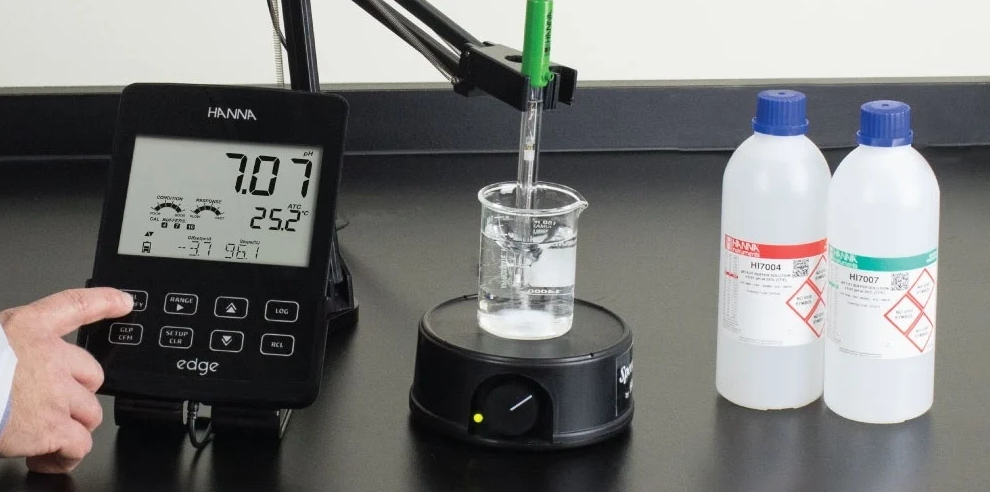+44 (0)1525 850 855
Order before 4pm for same day dispatch
Weekdays only
Menu
-
MenuBack
-
Home
-
-
By product type
- Benchtop Meters
- Chemical Dosing Pumps
- Chemical Oxygen Demand (COD) Meters
- Chemical Test Kits
- Conductivity Meters
- Controllers & monitors - pH & multiparameter
- Dissolved Oxygen Meters
- Magnetic Stirrers
- pH Meters
- Photometers
- Spectrophotometers
- Thermometers
- Titrators
- Total Dissolved Solids Meters (TDS)
- Turbidity Meters
- Refractometers
- ORP Meters
- Other Accessories and Spares
- Conductivity Electrodes
- Dissolved Oxygen Probes
- Ion Selective Electrodes (ISE)
- ORP Electrodes
- pH Electrodes
- Thermometer Probes
- Titration Electrodes
- Total Dissolved Solid Probes (TDS)
- Turbidity Electrodes
- Chemical Oxygen Demand (COD) solutions
- Conductivity Solutions
- Dissolved Oxygen Solutions
- Food and Drink Care Solutions
- Groline Solutions for Agriculture
- Ion Selective Measurement Solutions
- ORP Solutions
- pH Solutions
- Photometer solutions
- Pool, Spa & Hot Tubs Solutions
- Refractometer Solutions
- Titration Solutions
- Total Dissolved Solids Solutions (TDS)
- Turbidity Solutions
- Acidity
- Alkalinity
- Aluminium
- Ammonia
- Ascorbic Acid
- Bromine
- Calcium
- Carbon Dioxide
- Chloride
- Chlorine Dioxide
- Chlorine
- Chromium
- Copper
- Cyanide
- Cyanuric Acid
- Dissolved Oxygen
- Fluoride
- Formaldehyde
Meters
Electrodes and Probes
Solutions
Reagents
-
-
-
By Parameters
- Chemical Oxygen Demand
- Conductivity
- pH
- Salinity
- Dissolved Oxygen
- Temperature
- Total Dissolved Solids
- Turbidity
- Multi Parameter Devices
- Acidity
- Alkalinity
- Ammonia
- Aluminium
- Ammonium
- Anionic Surfactants
- Ascorbic Acid
- Boron
- Bromide
- Bromine
- Cadmium
- Calcium
- Carbon Dioxide
- Chloride
- Chlorine
- Chlorine Dioxide
- Colour
- Chromium
- Copper
- Cyanide
- Cyanuric Acid
- Fluoride
- Formaldehyde
- Glycol
- Hardness
- Hydrazine
- Hydrochloric Acid
- Hydrogen Peroxide
- Hypochlorite
- Iodide
- Iodine
- Iron
- Lead
- Magnesium
- Manganese
- Molybdenum
Main Parameters
Individual Parameters
-
-
-
-
-
-
-
-
-
-
-
By product type
- Back
-
Meters
- Back
- Benchtop Meters
- Chemical Dosing Pumps
- Chemical Oxygen Demand (COD) Meters
- Chemical Test Kits
- Conductivity Meters
- Controllers & monitors - pH & multiparameter
- Dissolved Oxygen Meters
- Magnetic Stirrers
- pH Meters
- Photometers
- Spectrophotometers
- Thermometers
- Titrators
- Total Dissolved Solids Meters (TDS)
- Turbidity Meters
- Refractometers
- ORP Meters
- Other Accessories and Spares
- pH accessories and spares
- Photometer and Turbidity accessories
- Thermometers accessories and spares
- Electrodes and Probes
-
Solutions
- Back
- Chemical Oxygen Demand (COD) solutions
- Conductivity Solutions
- Dissolved Oxygen Solutions
- Food and Drink Care Solutions
- Groline Solutions for Agriculture
- Ion Selective Measurement Solutions
- ORP Solutions
- pH Solutions
- Photometer solutions
- Pool, Spa & Hot Tubs Solutions
- Refractometer Solutions
- Titration Solutions
- Total Dissolved Solids Solutions (TDS)
- Turbidity Solutions
-
Reagents
- Back
- Acidity
- Alkalinity
- Aluminium
- Ammonia
- Ascorbic Acid
- Bromine
- Calcium
- Carbon Dioxide
- Chloride
- Chlorine Dioxide
- Chlorine
- Chromium
- Copper
- Cyanide
- Cyanuric Acid
- Dissolved Oxygen
- Fluoride
- Formaldehyde
- Glycol
- Hardness, Calcium
- Hardness, Magnesium
- Hydrazine
- Hydrogen Peroxide
- HypoChlorite
- Iodine
- Iron
- Lead
- Magnesium
- Manganese
- Molybdenum
- Nickel
- Nitrate
- Nitric Acid
- Nitrite
- Nitrogen
- Ozone
- Peroxide
- pH
- Phenols
- Phosphate
- Phosphorus
- Potassium
- Salinity
- Silica
- Silver
- Sodium Chloride
- Sodium Hydroxide
- Sulphate
- Sulphite
- Sulphuric Acid
- Surfactants, Anionic, Cationic, Nonionic
- Zinc
-
By Parameters
- Back
- Main Parameters
-
Individual Parameters
- Back
- Acidity
- Alkalinity
- Ammonia
- Aluminium
- Ammonium
- Anionic Surfactants
- Ascorbic Acid
- Boron
- Bromide
- Bromine
- Cadmium
- Calcium
- Carbon Dioxide
- Chloride
- Chlorine
- Chlorine Dioxide
- Colour
- Chromium
- Copper
- Cyanide
- Cyanuric Acid
- Fluoride
- Formaldehyde
- Glycol
- Hardness
- Hydrazine
- Hydrochloric Acid
- Hydrogen Peroxide
- Hypochlorite
- Iodide
- Iodine
- Iron
- Lead
- Magnesium
- Manganese
- Molybdenum
- Nickel
- Nitrate
- Nitrite
- Nitrogen
- ORP
- Oxygen
- Ozone
- Peroxide Value
- Phenols
- Phosphate
- Phosphorus
- Potassium
- Potassium Chloride
- Salinity
- Silica
- Silver
- Sodium
- Sodium chloride
- Sugars & Brix
- Sulphate
- Sulphide
- Sulphite
- Sulphur Dioxide
- Tartaric Acid
- Zinc
- Agriculture
- AQUARIUM
- FOOD
- LABORATORY
- POOLS, SPAS & HOT TUBS
- WATER
- Contact Us
- KNOWLEDGE HUB








